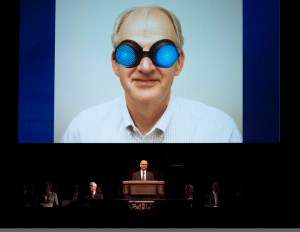A BYU engineering professor invited students to see through the eyes of a designer and learn how to better design their own world at Tuesday’s campus forum.
To help students see like a designer, Spencer Magleby, professor of mechanical engineering and associate dean of the Ira A. Fulton College of Engineering and Technology, began by saying he wanted students to appreciate the impact that engineering design has on their daily lives.
“This world of annoyances and wonders is the cumulative result of design decisions,” Magleby said. He then invited the audience to join him and “examine some common products in our world and infer some of the more apparent design decisions that are in them.”
One of the common products Magleby examined was his Volkswagen GTI. After extolling the virtue of his car’s engine, Magleby suggested that the sun roof was very poorly designed.

“It is much more complex to use than actually driving the car,” Magleby quipped. “Who decided that we needed six levels of openness on a sun roof?”
Magleby also discussed some specific design decisions that seem apparent in other everyday items such as his iPhone or automatic paper towel dispensers.
After talking about specific design decisions, Magleby said he wanted the audience to understand that engineering is a process that helps designers make such design decisions.
He explained that design engineers begin this process by trying to understand the needs of the situation at hand. Once they understand the needs, they create concepts to meet those needs. According to Magleby, this is where innovation can really take place as designers explore new and unique ideas and inventive approaches for solving the problem.
The next step design engineers take is to evaluate the concepts and determine which ones to develop. They then make models and use calculations to predict the performance of those models. Finally the design is tested and then refined as steps in the process are repeated.
With the process of design engineering explained, Magleby continued by inviting the audience to peer into the mind of a designer.
“Design engineers are just people that understand how to appropriately execute the type of process we just looked at,” Magleby said.
He then illustrated this by describing how one engineering student at BYU has been able to apply principles from origami to design other practical devices. By extracting concepts from the basic shapes of origami, innovative solutions become available, such as making shapes with complex motion out of a single folded piece of material.
Finally, Magleby suggested people’s agency gives them the responsibility to design the world and their lives.
He explained that people often talk about agency in terms of a choice between good and evil, but he believes it is much more than that.
“Most of our decisions are not about abstractly choosing between good and evil, but of making the decisions that guide and direct our lives,” Magleby said. “We might call it designing our lives.”




